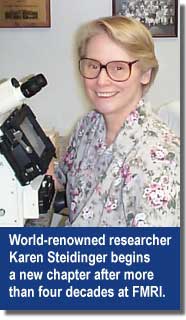
|
|
|
PROFILE: Dr. Karen A. Steidinger |
|
|
Although she officially retired June 30, "that doesn't mean I'm going to stop working," said Steidinger, who regularly logged about 60 hours a week for nearly four decades at the Florida Marine Research (FMRI) in St. Petersburg. The former senior research scientist has seen the name of FMRI change a handful of times, watched new microscope and DNA fingerprinting technology revolutionize the way she does science, and catalogued the kaleidoscope of names given to the tiny tough-to-classify organisms she studies. "Change is one of the few things that should be taken for granted," she said. Steidinger admits that her office light often burns brightly when most have called it a day. A world-renowned expert in harmful algal blooms, she's committed to nailing down the life cycle of the organism that causes Florida red tides. This critter was renamed Karenia brevis after Steidinger in 2001, to recognize her tremendous contributions to dinoflagellate research. Dinoflagellates are one-celled organisms that are commonly called "algae." When they reproduce in large numbers, they may "bloom," a natural phenomenon with which Florida residents are familiar (usually in the late summer and early fall months). Some of these "harmful algal blooms" (HAB) kill fish and cause respiratory irritation in humans. Others light up the water like fireflies in a phenomenon called bioluminescence (See related story). Steidinger's been nothing but helpful to research and more importantly, the people around her. "A wonderful benefit from life is having the opportunity to interact with people, to learn from them, and to help them," she said. Steidinger's list of accomplishments tells the tale of a jack-of-many-trades and master of most. She's seen tremendous success in science, management, policy, and education, and developed a solid HAB program now staffed with 22 research assistants. When she served as chief of FMRI, she boosted her budget from $5000 to $5 million in seven years, established many programs still in existence today, and secured funding to develop the state-of-the-art marine science complex in which she works. Perhaps her most intriguing mark of distinction is the superhero cartoon called Kruell Kruell Karina, Queen of the Fish Kills, recently named after Steidinger on a website developed by the National Oceanic and Atmospheric Administration (NOAA). "I honestly feel I haven't left enough because I haven't left anything tangible," said Steidinger. She's alone in that assessment. All told, she has advised more than 18 countries on HAB events, and has authored more than 70 publications on algae blooms. Last October, she convened the 10th International Conference on Harmful Algal Blooms in St. Petersburg Beach. No wonder the FMRI auditorium was recently named the "Karen A. Steidinger Auditorium." "Basically everyone in the world thinks she's a phenomenal mentor. There's just no way to replace Karen," said Jennifer Wheaton, a research administrator at FMRI who has known Steidinger for 30 years. Wheaton was quick to add: "Actually though, she won't be leaving the profession. I'm expecting Karen to still be around." She's right about that. "I have mixed feelings about this retirement because I'm not retiring," Steidinger said. "I've already signed up as a volunteer. But I've got 10 more papers to write, and I've got to finish the life cycle of brevis," said Steidinger, who said she will never get used to seeing her name in the literature. "I will also consult and teach, and I want to write children's books after that," she said. Good thing for us that retirement for Steidinger never looked so busy. |
|
 Karen Steidinger couldn't wait to retire so she can work harder than ever.
Karen Steidinger couldn't wait to retire so she can work harder than ever.